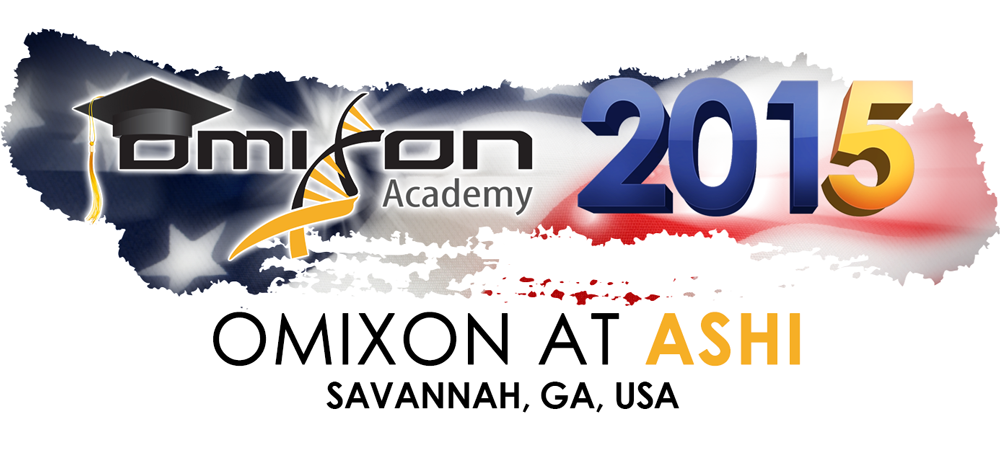Omixon announce today that Holotype HLA™ and other Omixon products will be featured in four oral presentations and 12 poster presentations at the annual meeting of the American Society for Histocompatibility and Immunogenetics (ASHI) in Savannah, Georgia. Additionally, in the Tuesday Vendor Symposium, Omixon’s CEO, Tim Hague, will present extended results and experiences during the Holotype Early Access Program (EAP), which combines the data from 24 participant labs in 13 countries constituting more than 1500 samples.
In the session entitled “New Assays Genomic/Proteomics” (Sept. 29, 2pm to 3:30pm) Alex Sheh from the Dedham HLA Laboratory at the American Red Cross will present “High-throughput sequencing using next-generation sequencing within 72h” featuring Holotype HLA automated on liquid handling instruments and sequencing with 150×150 paired end chemistry on the Illumina MiSeq. Holotype HLA results were 100% concordant with the Sanger-based sequencing results and the official ASHI proficiency testing results for the 5 loci tested (HLA-A, HLA-B, HLA-C, HLA-DRB1 and HLA-DQB1). The latest runs from the lab include using the 7-locus configuration of Holotype on samples extracted from either blood or buccal swabs – with similar high-quality results within 72 hours.
Of additional interest in this session is the performance comparison study presented by Karen Sherwood from the University of British Columbia who will compare Holotype HLA to three other NGS-based technologies. A total of 1680 loci were analyzed and compared across metrics such as read depth uniformity and ambiguity. Their results demonstrate that NGS offers precise, ultra-high resolution and complete sequence information in a high-throughput, cost effective method for improved HLA matching in medical research transplantation and HLA-related disease diagnosis.
At the Omixon Vendor Symposium at 12pm on Tuesday Sept 29, CEO Tim Hague will present results from the worldwide Holotype Early Access Program (EAP). The Holotype EAP ran for nine months and the data presented is combined from 24 labs across 13 countries that have genotyped more than 1500 samples (>10,000 loci). Among the participating labs are City of Hope, University of Chicago Medicine, ARUP, Yale University, UCSF, McGill University, Children’s Hospital of Los Angeles and the Red Cross in Dedham, MA. Three early adopters will present their experiences at the Symposium, and Professor Dimitri Monos, the inventor of Holotype HLA will conclude the session speakers.
Chief Commercial Officer at Omixon Dr. Peter Meintjes notes that “While the results of the Holotype EAP are impressive on their own, the greatest achievement Omixon has demonstrated is that customers with no prior NGS experience have been able to confidently roll out Holotype HLA and obtain accurate data with their first runs.” Dr. Meintjes emphasized that the reasons behind the successful results are clear “Omixon’s Field Application Scientists have expertly executed on our Customer Success Program in which every lab has been trained by one of our FAS Team. The quality of training, documentation and follow up data analysis walk throughs make adopting Holotype HLA a seamless experience.”
Omixon at ASHI 2015
Sept 28 – Oct 02, 8am-7pm | Omixon will be exhibiting at Booth #612 throughout the conference
Sept 28, 10am-12:30pm | Introduction to HLA Twin 1.1 – Quality Controls and the Traffic Light System (Basic Workshops) – Register here
Sept 28 1pm-3:30pm | Identification of Reference Mistypings with Holotype HLA (Advanced Workshops) – Register here
Sept 29, Noon-2pm | Holotype EAP Success Symposium – Register here
Omixon Featured in Talks and Posters
OR25 | Sheh A. et al. (2015) – High-throughput sequencing using next-generation sequencing within 72h
OR22 | Sherwood K. et al. (2015) – Towards clinical NGS HLA-Typing: A performance comparison of Next-Generation Sequencing technologies for DNA HLA typing in a clinical diagnostic environment
OR23 | Clark P. et al. (2015) – Elucidating the targetome of the HLA-B intron 4 derived miRNA, miR-6891 and allele specific miRNA isoforms
OR39 | Clark P et al. (2015) – De Novo Assembly of the Major Histocompatibility Complex Using Single-Molecule Real-Time Sequencing of Large Contiguous DNA Fragments Captured by Targeted Region Specific Extraction
P095 | McGowan K. and Bow L. (2015) – Establishing a Next Generation Sequencing laboratory for high resolution HLA typing
P078 | Lan J. et al. (2015) – Unambiguous HLA genotyping using long-range PCR and next-generation sequencing (NGS) on buccal-extracted DNA: Results from 4000 donor recruitment samples
P155 | Melista E. et al. (2015) – Towards a new Gold Standard for molecular HLA Typing
P133 | Juhos Sz. et al. (2015) – Deriving HLA genotyping from whole genome sequencing data using Omixon HLA TwinTM in G3’s global clinical study
P128 | Duke J. et al. (2015) – HLA typing by NGS in the clinical lab: our one and a half years experience
P131 | Clark P. et al. (2015) – Generation of high confidence HLA genotyping and consensus sequences for class I HLA loci using the NGS-based Omixon Holotype HLA typing system and the Illumina Miseq platform
P048 | Ferriola D. et al. (2015) – Enhanced characterization of 109 genomic dna reference material for 6 HLA loci by next-generation sequencing (NGS)
P091 | Huang Y. et al. (2015) – Automation of the amplification and library preparation steps for HLA typing using the NGS-based Holotype HLA kit and the Hamilton STARlet system
P165 | Thomas D. et al. (2015) – Clonal amplification rather than cloning to identify novel alleles: a hematopoietic cell transplant (HCT) case study
P114 | Wang J. et al. (2015) – NGS HLA typing – Single center experience with Omixon Holotype HLA X4 KIT and HLA twin data analysis
P028 | Brown N. et al. (2015) – Identification and sequencing of novel alleles: Utility of next-generation sequencing methods






